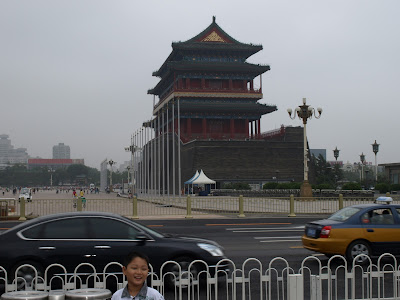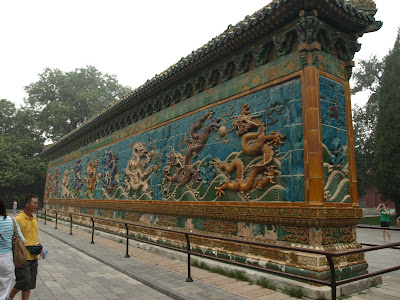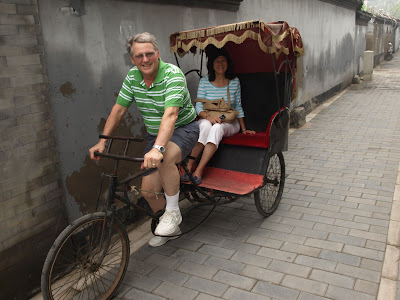Our first look at the Square
The Tiananmen Gate to the Forbidden City was built in 1415 during the Ming Dynasty.
The large building in the background is The Revolutionary History Museum (East side).
The Great Hall of the People, which is the seat of China's government, is on the opposite side (West side).
The Monument of the Peoples Heroes represents the working people who fought for the Republic. One of 2 monuments (Picture below) to the people in front of Mao's tomb.
Represents the soldiers who fought for the Republic.
Mausoleum built after Mao's death in 1976
The Meridian Gate
Good bye to the Tiananmen Square
Waiting for Tony, our tour guide, to get the tickets for us to enter the Forbidden City.
The Forbidden City, a UNESCO World Heritage site, is the world's largest palace complex, consisting of many buildings with 9,999 rooms protected by a 20 foot wide moat and a 32 foot high wall. We, of course, did not see the entire palace. The Forbidden City was the imperial palace during the Ming and Qing Dynasties where outside visitors were forbidden for five centuries. it was built from 1406 to 1420 by the third Ming emperor Yongle, who upon usurping the throne move his capital from Nanjing to Beijing. In 1911 the Qing dynasty fell to the republican revolutionaries. The last emperor, Puyi, continued to live in the palace after his abdication until he was expelled in 1924. Twenty-four emperors lived and ruled from this palace during a 500-yeaar span.
Tony, our tour guy, in the red shirt and Myra with her China umbrella before the Meridian gate.
Meridian Gate
Puyi awaits us. After seeing the movie the Last Emperor which was filmed in the Forbidden city. It was just unbelievable to walk where you know the past emperors have passed.
Going through the gate with hundreds of other people with umbrellas.
Inner Golden Water Bridge- The Inner Golden Water River flows beneath the the Inner Golden Water River Bridges. The central bridge was used exclusively by the emperor. The two flanking it were for use by members of the royal family. The two outer bridges were for court officials. The bridges have marble balustrades richly carved with dragon and phoenix motifs. The Inner Golden Water River Bridges were supposed to represent the five Virtues preached by Confucius, benevolence, righteousness, rites, intelligence and fidelity. They were shaped like five arrows reporting symbolically to Heaven, because the emperor considered himself the Son of Heaven.
Gate of Supreme Harmony is the second major gate at the southern side of the Forbidden City.
It is flanked by two minor gates, Zhendu Gate to the west and Zhaode Gate to the east.The central stairway was reserved exclusively for the Emperor and his immediate attendants, as was the central entrance of Meridian Gate.
These fancy rooftop decorations were only allowed on the official buildings of the empire. The more important the person the more figures on the roof eves.
At the tail of the procession will be an imperial dragon representing the authority of the state.
At the head of the procession will be a man riding a Phoenix, one legend suggests that this represents a minon of the emperor who grew greedy for power and was hanged from the roof gable for treason. Another version of this figurine is an immortal riding a fenghuang-bird or qilin. Yet another interpretation is that this is a person serving the emperor, being watched by the following beasts.
In between will be mythical beasts, usually an odd number of them. The mythical beasts are set to pounce upon the man and devour him should he stray from performing his duties with faithfulness and rectitude.
- Dragon, - the dragon protects against fire by controlling the rain and the sea. It is the primary symbol of the imperial throne.
- Phoenix, - the phoenix is the king of birds and controls the wind and air.
- Lion, the lion is the king of the beasts and the most powerful of the animals. The lion protects the country and the imperial rule.
- Heavenly horse, can run like the wind and travel thousands of miles in a day.
- Auspicious seahorse, has control over water to protect buildings from fire.
- Suan Ni, a mythical beast which is a combination of lion, wild beast, and wild horse.
- Guardian fish, wind- and storm-summoning fish.
- Xiezhi, a fabulous monster, which could tell right from wrong and use its horn to gore an evildoer whenever there is a fight.
- Bull,- the bull dispels evil and fights the enemy with its horns
Hall of Central Harmony and behind it Hall of Preserving Harmony
We are waiting for the tour group as each of us visits the "Happy Place" as our tour guide call the restroom.
The loving swans are in center of the tile wall This is jade
First electric lights in the Palace
Imperial Garden
One of the four pavilion symbolizing the four seasons
I think this is the Hall of Imperial Peace
The moat that surrounds the Forbidden City and one of the four Corner Watchtowers as we leave the Forbidden City.
I'm Loving It .... McDonald's









































































